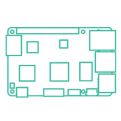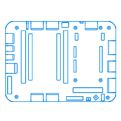|
|
| (59 intermediate revisions by 5 users not shown) |
| Line 1: |
Line 1: |
| − | {{Infobox item | + | {{#tweekihide:firstHeading|sidebar-left|sidebar-right}}__NOTOC__ |
| − | |name=5.65inch e-Paper Module (F)
| + | |
| − | |img=[[File:5.65inch-e-Paper-Module-F-2.jpg|300px|link=https://www.waveshare.com/5.65inch-e-paper-module-f.htm]]
| + | <div style="background-color: #343434;text-align: center;color: white;padding: 20px;margin: 8px;"> |
| − | |caption=880x528, 7.5inch E-Ink raw panel without driver board | + | =5.65inch e-Paper Module (F) Manual= |
| − | |category=[[:Category:OLEDs / LCDs|OLEDs / LCDs]], [[:Category:LCD|LCD]]
| + | </div> |
| − | |brand=Waveshare | + | <p></p> |
| − | |{{#urlget:amazon|default}}=display
| + | {{ContentGrid|grid-gap=25px |
| − | |website_cn=[https://www.waveshare.net/shop/5.65inch-e-Paper-Module-F.htm 官方中文站点] | + | |content = |
| − | |website_en=[https://www.waveshare.com/5.65inch-e-paper-module-f.htm Waveshare website] | + | {{StudyCard |
| − | |interface1=SPI | + | |img=[[File:E-Paper_Introduction_4.jpg|121px|link=https://www.waveshare.com/wiki/5.65inch_e-Paper_Module_(F)_Manual#Overview]] |
| − | |related= | + | |heading = Introduction |
| − | {{Product List|OLEDs / LCDs/e-Paper}}
| + | |content = Parameters, principles, and precautions |
| | }} | | }} |
| | + | {{StudyCard |
| | + | |img=[[File:Rapberry Pi.jpg|121px|link=https://www.waveshare.com/wiki/5.65inch_e-Paper_Module_(F)_Manual#Working_With_Raspberry_Pi]] |
| | + | |heading = Working with Raspberry Pi |
| | + | |content = User guides for the development demo of C language, Python |
| | + | }} |
| | + | {{StudyCard |
| | + | |img=[[File:Arduino00.jpg|121px|link=https://www.waveshare.com/wiki/5.65inch_e-Paper_Module_(F)_Manual#Working_With_Arduino]] |
| | + | |heading = Working with the Arduino |
| | + | |content = User guides for the development demo based on Arduino UNO R3 |
| | + | }} |
| | + | {{StudyCard |
| | + | |img=[[File:Jetson Arduino00.jpg|121px|link=https://www.waveshare.com/wiki/5.65inch_e-Paper_Module_(F)_Manual#Working_With_Jetson_Nano]] |
| | + | |heading = Working with the Jetson Nano |
| | + | |content = User guides for the development demo of C language, Python |
| | + | }} |
| | + | {{StudyCard |
| | + | |img=[[File:Sunrise X3 Pi.jpg|121px|link=https://www.waveshare.com/wiki/5.65inch_e-Paper_Module_(F)_Manual#Working_With_Sunrise_X3_Pi]] |
| | + | |heading = Working with Sunrise X3 Pi |
| | + | |content = User guides for the development demo based on Python |
| | + | }} |
| | + | {{StudyCard |
| | + | |img=[[File:STM321.jpg|121px|link=https://www.waveshare.com/wiki/5.65inch_e-Paper_Module_(F)_Manual#Working_With_STM32]] |
| | + | |heading = Working with the STM32 |
| | + | |content = User guides for the development demo based on STM32CubeMX |
| | + | }} |
| | + | {{StudyCard|img=[[File:E-Paper_ESP32.jpg|110px|link=https://www.waveshare.com/wiki/5.65inch_e-Paper_Module_(F)_Manual#ESP32.2F8266]] |
| | + | |heading = Working with ESP32/8266 |
| | + | |content = User guides for ESP32/8266}} |
| | | | |
| − | == Introduction ==
| + | {{StudyCard |
| − | This is an 5.65inch colorful e-Paper display module, 600x448 resolution, supports ACeP (Advanced Color Paper) sveen-color.
| + | |img=[[File:Resource0.jpg|121px|link=https://www.waveshare.com/wiki/5.65inch_e-Paper_Module_(F)_Manual#Resources]] |
| − | | + | |heading = Resources |
| − | {{Amazon|{{#urlget:amazon|default}}=display | + | |content = Documentation, procedures and data sheets, etc |
| − | |More = [https://www.waveshare.com/5.65inch-e-paper-module-f.htm More]}} | + | }} |
| − | | + | {{StudyCard |
| − | = Interfaces = | + | |img=[[File:FAQ01.jpg|121px|link=https://www.waveshare.com/wiki/5.65inch_e-Paper_Module_(F)_Manual#FAQ]] |
| − | {|class="wikitable"
| + | |heading = FAQ |
| − | |-
| + | |content = e-Paper frequently asked questions |
| − | | VCC || 3.3V
| + | }} |
| − | |-
| + | {{StudyCard |
| − | | GND || GND
| + | |img=[[File:support00.jpg|121px|link=https://www.waveshare.com/wiki/5.65inch_e-Paper_Module_(F)_Manual#Support]] |
| − | |-
| + | |heading = Support |
| − | | DIN || SPI MOSI
| + | |content = Technical support |
| − | |-
| + | }} |
| − | | CLK || SPI SCK
| + | }} |
| − | |-
| |
| − | | CS || SPI chip select (Low active)
| |
| − | |-
| |
| − | | DC || Data/Command control pin (High for data, and low for command)
| |
| − | |-
| |
| − | | RST || External reset pin (Low for reset)
| |
| − | |-
| |
| − | | BUSY || Busy state output pin (Low for busy) | |
| − | |}
| |
| − | ==SPI timing== | |
| − | ----
| |
| − | This product is an E-paper device adopting the image display technology of Microencapsulated Electrophoretic Display, MED. The initial approach is to create tiny spheres, in which the charged color pigments are suspending in the transparent oil and would move depending on the electronic charge. The E-paper screen display patterns by reflecting the ambient light, so it has no background light requirement. Under sunshine, the E-paper screen still has high visibility with a wide viewing angle of 180 degrees. It is the ideal choice for E-reading.
| |
| − | ; Communication protocol
| |
| − | ----
| |
| − | [[File:1.54inch-e-paper-manual-1.png|400px]] | |
| − | | |
| − | Note: Different from the traditional SPI protocol, the data line from the slave to the master is hidden since the device only has display requirement.
| |
| − | * CS is the slave chip select. When CS is low, the chip is enabled.
| |
| − | * DC is data/command control pin, when DC = 0, write command, when DC = 1, write data.
| |
| − | * SCLK is the SPI communication clock.
| |
| − | * SDIN is the data line from the master to the slave in SPI communication.
| |
| − | SPI communication has data transfer timing, which is combined with CPHA and CPOL.
| |
| − | # CPOL determines the level of the serial synchronous clock at idle state. When CPOL = 0, the level is Low. However, CPOL has little effect to the transmission. | |
| − | # CPHA determines data is collected at the first clock edge or at the second clock edge of the serial synchronous clock; when CPHL = 0, data is collected at the first clock edge.
| |
| − | * There are 4 SPI communication modes. SPI0 is commonly used, in which CPHL = 0, CPOL = 0.
| |
| − | As you can see from the figure above, data transmission starts at the first falling edge of SCLK, and 8 bits of data are transferred in one clock cycle. In here, SPI0 is in used, and data is transferred by bits, MSB first.
| |
| − | ==Color of e-Paper==
| |
| − | | |
| − | <!--
| |
| − | ==How to use == | |
| − | We provide several examples for testing, you first test the e-Paper by following the guides. If your developing board is different, you need to write your codes yourself by following the resources.
| |
| − | *[[Raspberry Pi guides for SPI e-Paper|For working with Raspberry Pi]]
| |
| − | *[[Jetson nano guides for SPI e-Paper|For working with Jetson Nano]]
| |
| − | *[[STM32 guides for SPI e-Paper|For working with SPI e-Paper]]
| |
| − | *[[ESP32 guides for SPI e-Paper|For working with ESP32]]
| |
| − | *[[ESP8266 guides for SPI e-Paper|For working with ESP8266]]
| |
| − | -->
| |
| − | | |
| − | == Resources ==
| |
| − | === Documentation ===
| |
| − | {{Commom Instruction of SPI e-paper}}
| |
| − | *[https://www.waveshare.com/w/upload/b/b6/5.65inch_e-Paper_Module_%28F%29.pdf 5.65inch e-Paper Module (F) Schematic]
| |
| − | *[https://www.waveshare.com/w/upload/7/7a/5.65inch_e-Paper_%28F%29_Sepecification.pdf 5.65inch e-Paper Module (F) Specification]
| |
| − | ===Demo code=== | |
| − | *[https://www.waveshare.com/w/upload/3/39/E-Paper_code.7z Demo codes for e-Paper]
| |
| − | *[https://github.com/waveshare/e-Paper Github]
| |
| − | | |
| − | ==FAQ == | |
| − | <!--{{e-Paper FAQ}}-->
| |
| − | {{e-Paper FAQ}}
| |
| − | | |
| − | ==Support==
| |
| − | {{Service00}}
| |









